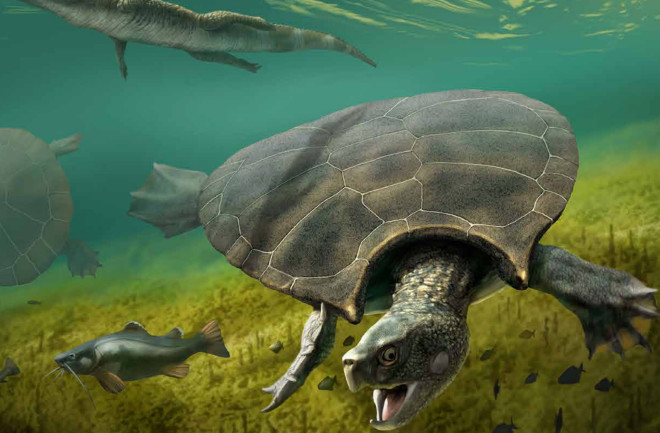When we talk about survival of the fittest, the first image that often comes to mind is that of giant, vicious predators capable of killing their way to dominance — whether that's Tyrannosaurus rex or the giant ichthyosaurs that once dominated the ocean.
While those titans went extinct eons ago, some of the giant reptiles that lived alongside them — specifically, turtles — focused more on defensive strategies, helping them survive against such fearsome predators. For example, paleontologists discovered a sea turtle fossil in Colombia dating back at least 120 million years ago to the Cretaceous; meanwhile Odontochelys semitestacea, a fossil discovered in China, is a near-turtle relative dating back 220 million years ago.
But which turtles were the largest to ever walk or swim the Earth, large enough to resist the attacks of fierce Cretaceous predators? Here are a few that put our modern-day leatherbacks and Galapagos tortoises to shame.
1. Archelon ischyros: The Largest Known Turtle
The largest turtles ever discovered date back to the late Cretaceous, about 74 million years ago. The species Archelon ischyros was a sea turtle that may have stretched beyond 15 feet long — more than twice as long as leatherbacks.
These turtles were similar to sea turtles today in appearance, but their sheer size puts them in another league altogether. They probably ate jellies and crustaceans like many sea turtles today. A nearly complete 16-foot specimen was discovered in the 1970s in North Dakota and is now housed at the Natural History Museum of Vienna.
Read More: Everything to Know About the Secret World of Sea Turtles
2. Protostega gigas: The 2,000-Pound Behemoth
While not quite as big as Archelon, Protostega gigas was still a giant of the late Cretaceous. These turtles swam in the inland sea that crossed North America from the Arctic Ocean to the Gulf of Mexico.
Some of these exceeded 12 feet and weighed more than 2,000 pounds, based on fossil specimens found by scientists. Protostega gigas probably had a similar diet to Archelon, and some fossils have been found with shark teeth embedded inside, revealing that their hard shells weren’t always a deterrent for marine predators.
Read More: How Old Is the Oldest Sea Turtle?
3. Leviathanochelys aenigmatica: Europe's Largest Known Turtle
This ancient creature was first discovered in the southern Pyrenees in Spain. When described in 2022, large turtles had been found in fossils deposits in North America, but this was the biggest European specimen.
“Based on the pelvis size, it is likely that Leviathanochelys [aenigmatica] was as large as Archelon, thus becoming one of the largest marine turtles found to ever exist,” wrote the authors of the study. They hypothesized that the sea turtle likely spent much of its time in the open sea. Not much else is known about this creature — aside from the pelvis, the researchers only recovered part of the back of the shell.
Read More: Why Were Prehistoric Marine Reptiles So Huge?
4. Ocepechelon bouyai: The Turtle That Used Its Snout To Suck Up Food
The species Ocepechelon bouyai was found in Moroccan deposits dating back to the late Cretaceous. This creature had an elongated head — more than two feet long — and likely fed through suction. “The feeding apparatus of Ocepechelon, a bony pipette-like snout, is unique among tetrapods,” the authors of a 2013 study wrote.
Paleontologists have only found the skull of this species, but based on comparisons with Archelon and Protostega skulls, the animal might have been more than 7.5 feet long from snout to tail, the authors of that study wrote. This strange form of feeding for a giant turtle illustrates the hugely diverse forms that chelonians took near the end of the Cretaceous — before the Chicxulub asteroid impact put an end to many of them.
Read More: 5 of the Most Interesting Prehistoric Marine Reptiles
5. Stupendemys geographicus: The Living Tank
Just like today, most of the biggest turtles of the past stuck to the sea. Not so with Stupendemys geographicus — a massive tank of a freshwater turtle that weighed more than 2,500 pounds and prowled lakes and rivers during the Miocene. In fact, it weighed about twice as much as leatherback sea turtles, and the males may have had horns on the front of their shells.
This reptile, which lived in Colombia and Venezuela, had a shell about 7.9 feet long. Bite marks show that large caimans might have tried their luck on this armored giant. Their nearest living relatives are the aquatic (and comparably small) Amazon river turtles.
Read More: Why Are Sea Turtles Endangered and How Can We Save Them?
Article Sources:
Our writers at Discovermagazine.com use peer-reviewed studies and high-quality sources for our articles, and our editors review them for accuracy and trustworthiness. Review the sources used below for this article:
Paleo Bios. Oldest known marine turtle? A new protostegid from the Lower Cretaceous of Colombia
Nature. How the turtle got its shell
Naturhistorisches Museum Wien. Fossil Vertebrates
Smithsonian National Museum of Natural History. One Large Turtle: Protostega gigas
Paleontological Society. Shark-Bitten Protostegid Turtles from the Upper Cretaceous: Mooreville Chalk, Alabama
Scientific Reports. A gigantic bizarre marine turtle (Testudines: Chelonioidea) from the Middle Campanian (Late Cretaceous) of South-western Europe
Sciences Advances. The anatomy, paleobiology, and evolutionary relationships of the largest extinct side-necked turtle

